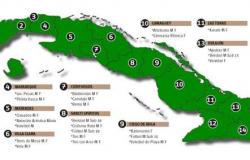
The fintech ecosystem, made up of financial technology ventures, continues to advance by leaps and bounds in Latin America and the Caribbean, which has allowed a greater number of people to have access to financial products today, including credit. In the last two years alone, nearly 670 new startups were created, bringing the number to 3,069 initiatives in 26 countries in the region. a growth close to 28 percent, as revealed by the most recent report on this industry prepared by the Inter-American Development Bank (IDB) and Finnovista.
According to the criteria of
Fintechs have been playing a leading role in the credit market not only for unbanked people but also for microentrepreneurs. Diego Herrera, Lead Financial Markets specialist at the IDB, warns that the lack of regulation makes it difficult to know how much credit these new actors are placing. However, Studies carried out with the University of Cambridge (2021) indicate that in the region we could be talking about some 5.8 billion dollars aimed at financing, especially, business activities, but warns that the lack of regulation makes it difficult to know how much credit these new actors place. at regional level.
“This was a sector that responded very well during the pandemic, especially to MSMEs, many of which used their credit card quotas to finance their activities, but then they did so through a fintech, which allowed them to “90 percent of the firms consulted maintain the number of employees, 85 percent increase their inventories and another similar percentage increase their sales and billing,” says the expert.
Herrera refers to another study carried out with the same university, which consulted 540 MSMEs from Argentina, Brazil, Chile, Colombia, Peru and Mexico, with an average loan of $3,917 in 2021. 61 percent of the companies used the resources obtained from Alternative Finance (AF) platforms for working capital, 8.2 percent for asset purchases, a similar percentage for refinancing and 7.8 percent for expanding their businesses.
But along with these legal financing alternatives, firms are emerging that, using ‘similar models and technologies’, make excessive charges for the resources they lend, intimidate and threaten debtors who, due to the high costs, hang up on payments, when They are not simple facades for criminal gangs dedicated to scamming the unwary.
“We work and take into account for our studies only platforms that belong to associations and are certainly not immersed in illicit activities,” warns Herrera, who comments that Much of the solution to this ‘digital drop by drop’ problem lies on the regulatory side.
“It is necessary to regulate the sector, as Brazil, Mexico and Colombia have done, and more recently Peru and Ecuador, so that it can be cleaned and there are no companies that want to carry out illicit activities and in this the call on two important issues is very important. , the development of institutional capacity in regulators and supervisors and the ability to regulate entities, which somehow allows the activity to be clearly defined and there to be no doubts about what is being offered,” comments the IDB expert.
Colombia is advancing in that direction. In the last three years, the fintech sector has made approaches with both the Financial Regulation Unit (URF), the Financial Superintendency and the Bank of the Republic to define a regulation in that direction and part of these advances have occurred through the side of open finance (open banking), which is key because it allows the generation of data that helps define the activities of the entities, which complements the regulations on crowdfunding (Decree 1357 of 2018).
Colombia among the leaders
Colombia is a relevant player in this nascent industry. After Brazil and Mexico, it is the third country with the largest undertakings and one of those that attracts the most investment to accompany these initiatives.
In 2023, financial technology (fintech) companies in Colombia received 45% percent of the $267 million invested in Colombian startups. This sector captured 46.3 percent of venture capital (VC) investments in Latin America, with nearly 1,834 million dollars through 196 transactions, sector data reveal. Currently the country has about 410 of these enterprises.
Fermín Bueno, founding partner of Finnovista, a leading innovation and venture capital firm committed to the development of the Fintech ecosystem, points out that having surpassed 3,000 startups in Latin America represents exponential growth (340 percent) in six years, but it is already beginning Let’s see that the growth rates in these leading countries are being limited, the same is not happening in other nations that are reaching this industry and are still growing at rates of more than 40 percent.
The report shows that the payments and remittances segment is not only the leader but also one of the fastest growing. Indeed, in the period analyzed (2017-23), it is observed that the Payments and Remittances segments (632 companies in the region); Loans (591), and Business Finance Management (413) remained the undisputed leaders, occupying the top three positions and experiencing average annual growth of 24, 31, and 28 percent, respectively.
Anderson Caputo, head of the Financial Markets Division of the IDB, mentions that these figures show the relevance that this industry is having in the economies and the daily lives of people to the extent that it increasingly shelters a greater number of these with their products and services.
“It is clear that fintech companies work more closely with consumers. 53 percent of these companies target people who are not banked and that gives much more weight to the idea that by supporting this segment, we can advance more quickly in terms of financial inclusion in the region,” says the expert.
The other relevant thing, he adds, is regarding the issue of regulation, but more as a warning, because if there is this positive correlation between the State and the development of the industry, it is very positive. However, only nine countries have regulated retail payment systems, only seven have regulated open finance and these are central issues in this new category.
The challenges
For experts, it is clear that there are several challenges that this industry has, such as maintaining developments in key segments, the recovery of investments that were reduced in recent years and the consolidation of regulations, among other factors.
For Anderson Caputo, the relevance of retail payments, regulation, training and adoption of technologies are challenges and must come together. In September 2024 we will sign a memorandum of understanding to join forces in the region and work on three fronts: appropriate public policies for the development of these systems, greater training, including of those who work in central banks and technology, where we have a project in which several countries and their central banks are interested in participating to promote this industry.
Herrera, for his part, considers that the regulatory challenge continues to be a priority and this must include all segments of this industry, something that the IDB has been leading and in which Colombia has stood out. We support the Banco de la República in the development of its interoperable payment system, we help the Superfinanciera establish its open finance roadmap, but these types of actions are not being taken throughout the region, he says.
“The regulatory challenge is immense. There is a positive correlation between regulation and the development of the ecosystem and these regulations are needed to overcome many challenges that the ecosystem has,” the expert specified.
For Fermín Bueno, we must be clear that there are micro and macro challenges, because if you look at fintech companies they have their needs, such as access to financing, the ability to scale and to innovate. While the challenges of the countries, in most cases, are regulatory, such as open finance, which has been waiting for more than four years and nothing has arrived.
“This delays the development of the country in terms of what this industry, the entrepreneurs and what the investors who have bet on these ventures can achieve,” says the Finnovista spokesperson.
According to the report, in terms of venture capital investment in the region, although it was reduced by half between 2021 and 2022, reaching 7.8 billion dollars, with a slight recovery in 2023, The fintech sector continues to be the one with the largest participation, with 43 percent of the total.





